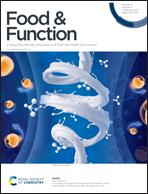Phenolic compounds from an Algerian medicinal plant (Pallenis spinosa): simulated gastrointestinal digestion, characterization, and biological and enzymatic activities
Abstract
Pallenis spinosa is a medicinal plant which is used in folk medicine as curative or preventive remedies for various diseases. Individual phenolic compounds from the methanolic extracts of its flowers, leaves and stem were determined by the high performance liquid chromatography method (HPLC) and total phenolic contents (TPC) were evaluated by Folin–Ciocalteu assay. The stability and bioactivity (antioxidant activity, micellar cholesterol solubility, α-amylase, and angiotensin converting enzymes (ACE) inhibitory effects) of these extracts in the gastrointestinal environment was determined before and after their protection in hydroxypropylmethylcellulose (HPMC) capsules. HPLC analysis revealed the presence of thirteen phenolic compounds with nine flavonoids and four phenolic acids. Except for kaempferol, the twelve other compounds have not been previously detected in the aerial part of the studied plant. Quantification of phenolics by HPLC and Folin Ciocalteu methods revealed that the highest TPC was detected in the flower extracts (104.31 ± 0.80 and 145.73 ± 0.48 mg EGA per g of extract, respectively). Leaf extracts displayed the best antioxidant capacity against the two tested radicals DPPH and ABTS (IC50 = 1.24 ± 0.03 and 0.94 ± 0.02 mg mL−1, respectively), FRAP assay (IC50 = 0.50 ± 0.02 mg mL−1), α-amylase inhibitory (IC50 = 1.25 ± 0.00 mg mL−1) and angiotensin activity with an inhibitory percent of 30.10 ± 0.12%. The best activity shown by stem extracts was against micellar cholesterol solubility (67.57 ± 0.00%). A strong decrease in TPC and their bioactivity was observed after the gastrointestinal digestion (GID) in non encapsulated extracts. These results showed that P. spinosa is a good source of phenolic compounds and GID affects significantly their composition, content and bioactivity.



 Please wait while we load your content...
Please wait while we load your content...